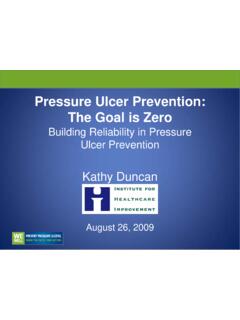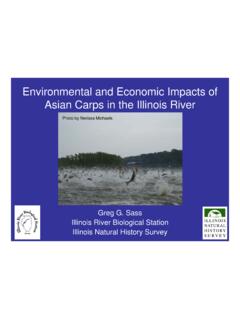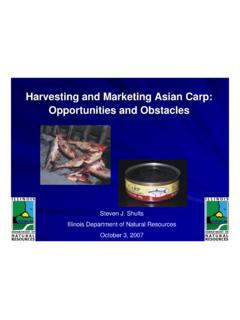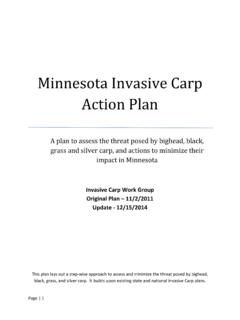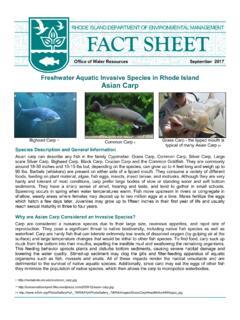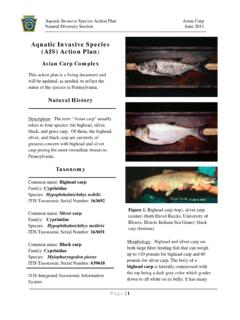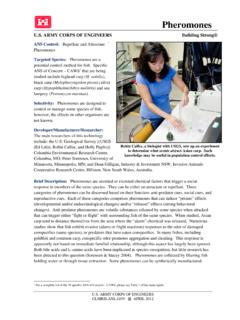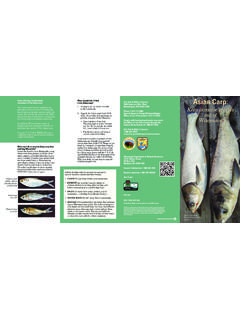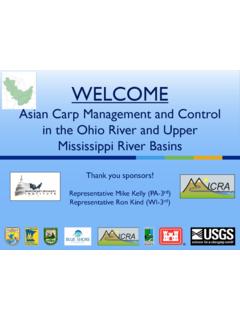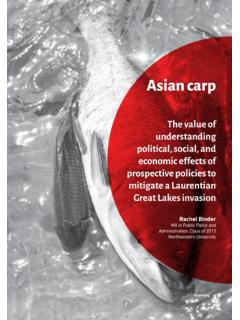Transcription of DNR NEWS ADVISORY - IN.gov
1 DNR news ADVISORY Indiana Department of Natural Resources 402 W. Washington St. W255 B Indianapolis, IN 46204-2748 Phone: (317) 232-4200 Recent reports and discussions about asian carp in Indiana lack clarity regarding a potential connection between the Wabash River and Maumee River basins and the potential for asian Carp movement across the two watersheds. To clear up these misunderstandings, the Indiana Department of Natural Resources offers the following information: -- Under normal conditions, there is no direct link between the Wabash River and the Maumee River. However, tributaries and drainage ditches near Eagle Marsh, a 705-acre restored wetland on the southwest side of Fort Wayne provide a potential connection under certain flooding situations.
2 -- The potential connection involves Graham McCulloch Ditch and Junk Ditch, which extend into Eagle Marsh. The two ditches are separated by a geographic divide between the two watersheds. There is no evidence that asian carp have breached this watershed divide. -- The McCulloch Ditch drains southwest from Fort Wayne into Little River (aka Little Wabash River) and then into the Wabash River near Huntington (Ind.). Junk Ditch drains northeast into the St. Marys River, which merges with the St. Joseph s River in downtown Fort Wayne to create the Maumee River. The Maumee flows into Lake Erie.
3 -- The area in which Eagle Marsh, McCulloch Ditch, Junk Ditch and Little River are located is a natural region geologically created by glacial movement at the end of the Ice Age more than 10,000 years ago. Under certain conditions, natural backwash of flooded tributaries, particularly the St. Marys, spreads across this broad, natural area and connects with tributaries of the Wabash. -- Although understanding and knowledge of this floodway connection is not new, attention is being focused on the Eagle Marsh area as part of the larger Great Lakes and Mississippi River Interbasin Study (GLMRIS) being conducted by the Army Corps of Engineers.
4 The Indiana DNR, Geological Survey, the Corps of Engineers and others are working collaboratively to calculate the flooding conditions necessary to provide asian carp a passageway into the Maumee watershed. -- Once a determination has been made on the relative probability of fish passage in the Eagle Marsh area, agencies will quickly turn to planning efforts on preventive measures to deter asian carp movement into the Maumee River watershed. -- asian carp have been present in the Wabash River for nearly 15 years. DNR fisheries biologists first discovered them in 1996 during a survey at Hovey Lake Fish & Wildlife Area in the southwest tip of Indiana.
5 Since then, asian carp have been detected in spot locations on the Wabash River as far upstream as the dam at Roush Lake (Huntington County). -- The 91-foot-high concrete and earth dam at Roush Lake is an impassible barrier to further upstream movement through the Wabash River of asian carp and all other fish species. However, since the Little River enters the Wabash River downstream of the Roush Lake dam, there are no significant barriers in place to prevent fish movement through the Little River toward the watershed divide at Eagle Marsh, approximately 20 miles upriver. -- In late May of this year, a DNR fisheries biologist detected an asian carp spawning event (specifically silver carp) at river mile 303 south of Lafayette on the Wabash River.
6 That s more than 100 miles downstream from the Roush Lake dam (RM ) and approximately 125 miles from the watershed divide in the upper reach of Little River/Graham McCulloch Ditch near Eagle Marsh. -- The USGS has documented several occurrences of asian carp in Lake Erie dating back to at least 1995 ( ). Again, there is no evidence asian Carp have breached the watershed divide in the Fort Wayne area. The asian carp reported in Lake Erie have been individual findings with no evidence of a sustainable population. These isolated findings are believed to be from intentional releases with no reported evidence of a sustainable population.
7 -30- Contact: Phil Bloom, DNR Communications, 317/232/4003, or


